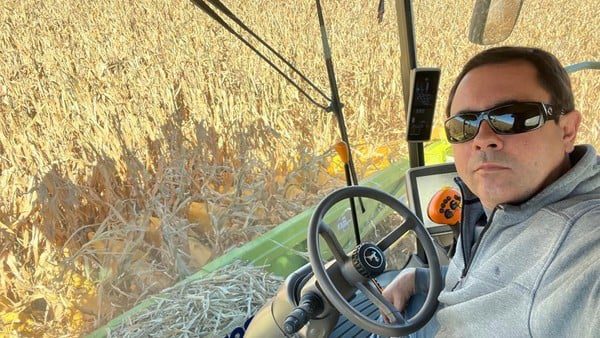Global Courant 2023-04-20 16:32:00
He is a contractor for harvesting, fertilizing and planting service crops, his name is Diego Biglia (47) and he started in the profession when he was a boy, accompanying his father who has been a contractor since he was 15 years old and continues in the activity.
“We are a family of contractors from Morse, near Junín, known as a harvest town because there are so many harvesters, although there are fewer and fewer because the young prefer to do other things and the old are getting tired. The truth is that my family has been dedicated to this business all their lives”.
With each of his two combines he averages between 2,000 and 2,500 hectares per year, starting with wheat and some barley depending on the year. Then the thick starts with high humidity corn that threshes for a feedlot, then it continues with traditional corn harvested dry, then soybeans and finally, for a few years, the year ends with late corn.
“This last crop is a modality that has appeared in recent years and has allowed us to increase the area without moving as much as we did in previous years, when we went further to harvest.” Now we are focusing on the south of Santa Fe and the northeast of the province of Buenos Aires, in the areas of Venado Tuerto, Villa Cañás, Teodelina, and further south, Ameghino, Coronel Granada, General Pinto, ”he says.
“With the fertilizer and pneumatic seeder we expanded our annual work window,” says Diego Biglia.
The team
“Our team consists of two John Deere CS 670 combines with 40-foot draper heads and 16-row 52.5 cm and 12-row 70 cm cornfields, and everything related to connectivity and mapping. In fertilization and planting, we work with an Altina 2019 pneumatic fertilizer installed on a 30-meter-wide plant, which gives us the possibility of developing a slightly larger work window, during the months that we are stopped during the harvest,” he says. .
They sow on soybeans before the leaf falls and on corn in a state almost at harvest, it is a piece of equipment that is high enough to work in high-altitude corn. “Usually we grow vetch on soybeans, but most of it is done with oats, rye.”
“With this team, as it has faster and cheaper mobility, we move a little further, although not much. So much so that we have rejected jobs in the north because logistics are complicated and movement is expensive, which the work usually In general, it does not justify it”, he analyzes.
In fertilization, the dryness affected their work since, the wheat received a small fertilization only in some cases. Then a rain was expected to make a second application, a condition to achieve better results. But that second rain never came. The same thing happened with corn, that is, a rain was expected to refertilize, but it never happened.
“Regarding the sowing of cover crops, the surface this year should be half of what we did the previous year, since it is a work system that if it does not have moisture it is very difficult for it to work. Before the dry season, we did between 10,000 and 15,000 ha per year between planting and fertilization, and 60% of this is planting and 30% fertilization.”
Due to its clearance, the pneumatic fertilizer can work on fairly grown corn, approximately 1.50 meters high.
“Regarding the harvest, the drought also affected them a lot because much less than half of the initially planned area of wheat was harvested because its yield did not justify the task.” As for the coarse grain, the picture is similar, since Diego foresees that many lots will be harvested, but with very low yields.
“We were harvesting some soybeans in the Teodelina area with yields of 3 to 5 quintals/ha, that is, really low, and the part that is still green at the moment is expected to raise those amounts a bit, but in any case, it is not going to it won’t be half the normal years”, says Diego.
business drawbacks
“During the past year there was a lot of shortage of covers and when there is availability the prices have gone through the roof, and they are incomparable. Regarding spare parts, although we have combines that are manufactured in the country, the spare parts are imported and there are many shortages. In the concessionaires they have almost nothing and they manage with the stock of the terminals.”
Each combine harvester does between 2,000 and 2,500 ha per year on average in typical years.
He points out that prices in dollars increase month by month and are getting further and further away from being maintained because the rates are set according to the official dollar and, for example, a combine harvester that 3 years ago was worth US$ 350,000 today with a little more technology worth 1 million dollars. That is what makes it difficult to update machinery and technology.
Regarding the tax pressure, Diego defines it as giant, and this year, which will be very difficult due to the low yields and the smaller harvest area, they pay advances on profits that they will never have due to weather issues. But those advances are based on previous years. “It’s something that is derisory,” says Diego.
“Vehicle license plates in the province of Buenos Aires are enormous and the bureaucracy to travel through the routes is enormous. Thus the life of the contractor becomes more and more difficult and for some reason there are so many complete teams for sale of people who leave the activity, and who buy with the money from the sale two or three apartments for rent”.
“On the rural roads, through which we move the equipment so as not to disturb the routes, they are destroyed by the drought and because not enough works have been done lately, so that since there are no alternative roads, sometimes we have no other option. we move along the road”.
people wanted
“It is making it very difficult for us to find employees for the activity, because there is a lack of training for the people who want to work in it because the equipment is with technology that is a bit difficult to handle. For this reason, the Argentine Federation of Agricultural Machinery Contractors is beginning an effort to train young people, for example from rural schools, but we need support from companies and the state to cover expenses.
“Another drawback is the telephone signal” which, according to Diego, “is concentrating in the cities and the countryside is losing service. If we move 10 or 15 km from any city and the telephone signal is complicated. The harvesters have a SIM to send the harvest and operation data and sometimes it is difficult to take advantage of this aspect due to the lack of a good connection and we pay a subscription to work online and the truth is that the use of the system It is low”.
The harvesters are equipped with connectivity and mapping, online services for which they pay a subscription but are not always available.
Diego maintains that many times he travels 30 km to talk on the phone, and that expense plus the number of jobs that are lost due to not having a good connection, are excessive costs incurred for not having this service.
maturities
In an exceptional year, “the financing of purchased equipment was projected with a very different perspective from the current real one, in the number of hectares harvested, since the reduction that occurred is unprecedented, even reviewing 70 years of history. This changed the real accounts of all of us”, affirms our interviewee.
“It’s like an earthquake in a city and you have a construction company. It is devastating and in a very large area, and if we start to change work zones as we do under normal conditions, we will annoy each other and the competition will lower the prices of the tariffs in an unpredictable way”, says Diego Biglia.
Due to this exceptional situation, the request has been generated from the Argentine Federation of Agricultural Machinery Contractors before the national authorities, that the payments that are about to expire, for the financing of equipment, be postponed, and at this moment the contractors are waiting for a resolution to this effect.








